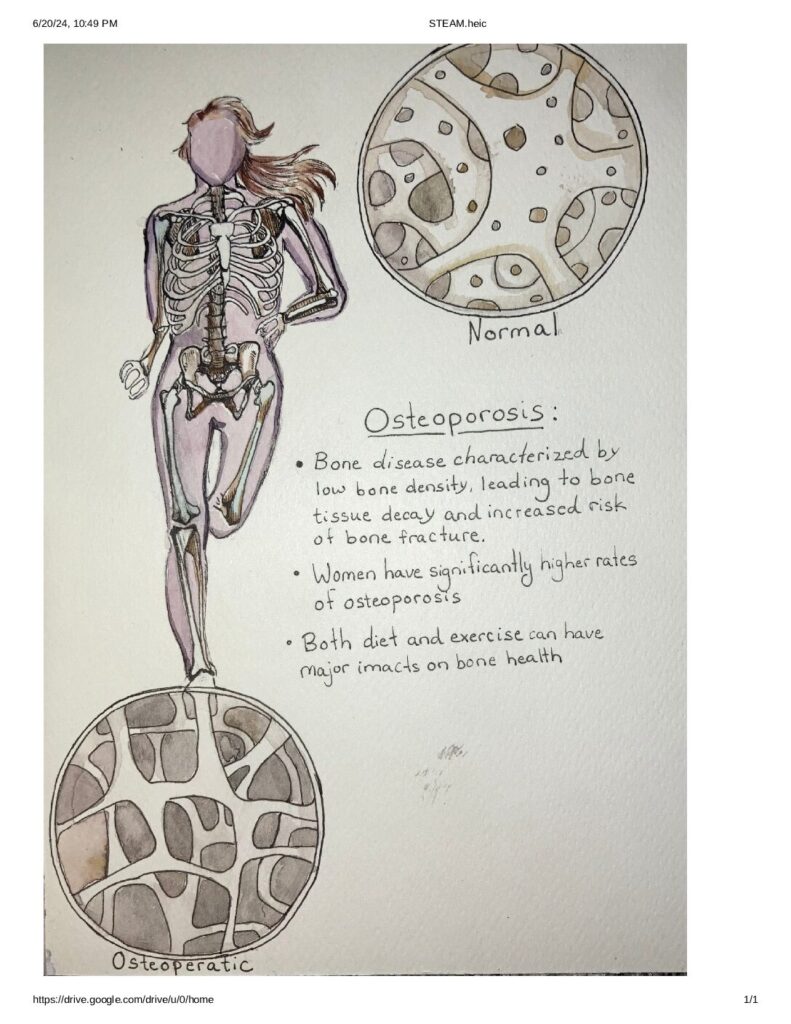As we age, it becomes increasingly important to take care of our bodies and preserve out health. There are many health problems that tend to arise in our later years. This is due to the fact that we are no longer growing and regenerating the same way we were when we were young. Such is the case with our bones. The decay of bone tissue, leading to low bone density and increased risk of fracture, is known as Osteoporosis is characterized by low bone density, which leads to bone tissue decay (McPhee et al., 2022). Ostroporisos is a very common disease affecting many. Nearly 10 million Americans have osteoporosis, 80% of whom are women (McPhee et al., 2022). I was choose this topic because am interested in what leads to bone tissue decay and how diet and exercise can impact this. I chose to create a visual representation of healthy vs. osteoporotic bone tissue using pen and watercolor.
Women have a very high risk of developing osteoporosis. Generally, men reach a higher peak bone mass than women, while women tend to have smaller bones and begin to lose bone mass sooner and more quickly. (McPhee et al., 2022). After menopause, bone loss in women becomes more rapid, starting with a loss of around 0.6 % per year by age 60 and reaching up to 2.1% per year by age 80 (Benedetti et al., 2018). This change observed after menopause is due to estrogen’s role in maintaining bone tissue (McPhee et al., 2022). When levels of estrogen decrease, we can see a correlation in decreasing bone mass. A major component in bone remodeling is credited to hormonal factors.
While there is nothing we can do to get back what has been lost when it comes to bone mass, there is a lot we can do to prevent and slow down the damage. The early years of life are essential to building bone minerals, with 40%-60% of adult bone mass accumulated during adolescence (McPhee et al., 2022). The most important factors to consider during this time and throughout adulthood are diet and exercise (McPhee et al., 2022). Insuring sufficient calcium intake and vitamin D, which supports calcium absorption, allows for the accumulation and maintenance of bone tissue (McPhee et al., 2022). Proper exercise places stress on the bones and can stimulate bone osteogenesis in those who suffer from osteoporosis (Benedetti et al., 2018).
Weight-bearing aerobic exercise, such as waking or running, must reach a level of intensity to be effective, while strength training and resistance exercises, such as lifting weights or swimming, increase bone mass in site-specific areas where stimulation occurs (Benedetti et al., 2018). It is especially important for women to incorporate regular strength training into their routine. Even a little bit every day can do a long way. It is recommended that both resistance training and weight bearing exercises be implemented (Cosman et al., 2014).
Benedetti, M. G., Furlini, G., Zati, A., & Letizia Mauro, G. (2018). The Effectiveness of Physical Exercise on Bone Density in Osteoporotic Patients. BioMed research international, 2018, 4840531. https://doi.org/10.1155/2018/4840531
McPhee, C., Aninye, I. O., & Horan, L. (2022). Recommendations for Improving Women’s Bone Health Throughout the Lifespan. Journal of women’s health (2002), 31(12), 1671–1676. https://doi.org/10.1089/jwh.2022.0361
Cosman, F., de Beur, S. J., LeBoff, M. S., Lewiecki, E. M., Tanner, B., Randall, S., Lindsay, R., & National Osteoporosis Foundation (2014). Clinician’s Guide to Prevention and Treatment of Osteoporosis. Osteoporosis international : a journal established as result of cooperation between the European Foundation for Osteoporosis and the National Osteoporosis Foundation of the USA, 25(10), 2359–2381. https://doi.org/10.1007/s00198-014-2794-2


While reading Lucca’s post I learned that nearly 10 million Americans, 80% of whom are women, have osteoporosis. Osteoporosis is known as when the decay of bone tissue leads to low bone density and an increased risk of fracture. Women tend to have smaller bones and begin to lose bone mass sooner and more quickly while men reach a higher peak bone mass than women. 0.6% per year by age 60 and 1.2% per year by age 80 is the percentage of how much bone loss occurs in women due to menopause. This is due to the fact that the estrogen levels we produce decrease which then cause a decrease in bone mass. Although the bone we lose can’t get gained back, there are several options of treatment that can help prevent it and possibly even slow the damage it’s causing to the bones. Most of our adult bone mass forms during adolescence, through this time of your adolescence exercise and diet are the most important factors when it comes to bone mass. Make sure you have enough intake of calcium and vitamin D, these two work together to allow accumulation and maintenance of bone tissue. Walking or running is not very effective unless it’s at a certain intensity level, unlike lifting weights or swimming which help increase bone mass but only in the areas you’re working out the most. Women have to make sure that we add some type of exercise in our daily routine since we are more prone to getting osteoporosis. While it is impossible to replace lost bone, there are a number of therapeutic methods that can assist prohibiting it from happening or even lessen the harm it is doing to the bones. The majority of our adult bone mass develops throughout adolescence; during this period, nutrition and activity are the most crucial components of bone mass. Make sure you are getting adequate calcium and vitamin D into your diet. These two factors combine to facilitate the growth and upkeep of bone structure. Unlike swimming or lifting weights, which assist develop bone mass, but only in the regions you’re working out the most, walking and jogging are ineffective unless they are done at a particular intensity. Given that women are more likely than males to develop osteoporosis, it is imperative that we incorporate exercise into our everyday routines.